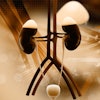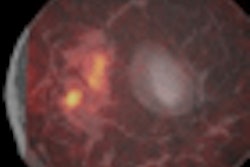Researchers in Boston say that CT angiography (CTA) can perform myocardial perfusion studies as accurately as SPECT, adding further evidence that cardiac CT could be used as a tool for single-study comprehensive heart exams.
Although cardiac CT scanning can identify coronary stenosis, very little data exist on its ability to detect stress-induced myocardial perfusion defects, wrote lead author Dr. Ricardo Cury and colleagues from Boston's Massachusetts General Hospital in the September 15 Journal of the American College of Cardiology (2009, Vol. 54:12, pp. 1072-1084).
They used a dual-source CT (DSCT) scanner to assess the feasibility of performing a comprehensive cardiac CT exam incorporating both stress and rest myocardial perfusion imaging, and compared CT's performance to the gold standard for MPI studies, SPECT.
In all, researchers examined 34 patients (61.4 ± 10.7 years; 82% male; mean body mass index, 30.4 ± 5 kg/m2) who had undergone nuclear stress testing and invasive angiography. Contrast-enhanced DSCT images were acquired at three different points: during adenosine infusion, at rest using prospective triggering, and with a delayed DSCT scan after seven minutes.
On a per-vessel basis, the CT perfusion exam delivered a sensitivity of 79% and a specificity of 80% for the detection of stenosis ≥ 50%, whereas SPECT myocardial perfusion imaging had a sensitivity of 67% and a specificity of 83%. For the detection of vessels with ≥ 50% stenosis with a corresponding SPECT perfusion abnormality, CT perfusion had a sensitivity of 93% and a specificity of 74%. CT perfusion during adenosine administration had a per-vessel sensitivity of 96%, specificity of 73%, and negative predictive value of 98% for the detection of stenosis ≥ 70%, the authors reported.
The accuracy of CT perfusion imaging in diagnosing significant stenosis affecting myocardial perfusion was virtually the same as with SPECT stress imaging, and the results of coronary CTA also compared favorably to those of cardiac catheterization, Cury and colleagues wrote. The mean CT perfusion dose of 12.7 mSv for all three scans was no higher than that of a single SPECT study.
"Adenosine stress CT can identify stress-induced myocardial perfusion defects with diagnostic accuracy comparable to SPECT, with similar radiation dose and with the advantage of providing information on coronary stenosis," the group wrote, adding that multicenter studies and a larger cohort are needed to better evaluate the technique.
Related Reading
DECT cuts tests as a one-stop myocardial, coronary artery exam, August 10, 2009
Dual-source CTA turns in mixed results for coronary stenoses, July 30, 2009
Adenosine stress DECT equivalent to SPECT, MRI, November 21, 2008
Study correlates CTA to angiography, myocardial perfusion SPECT, May 25, 2007
Stress MPI with Tc-99m SPECT identifies high-risk obese patients, September 1, 2006
Copyright © 2009 AuntMinnie.com



















